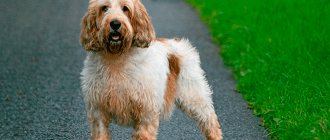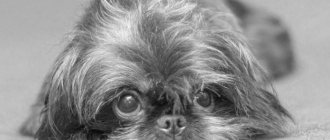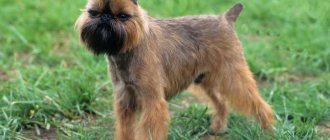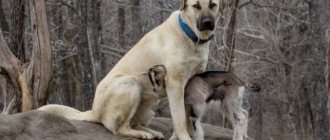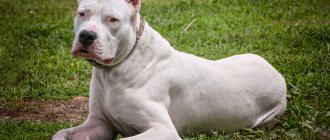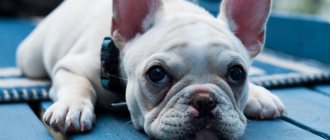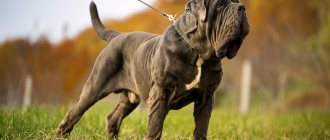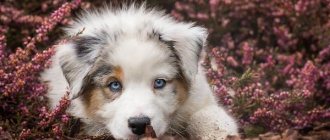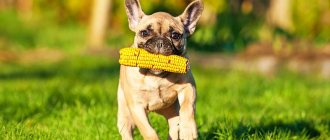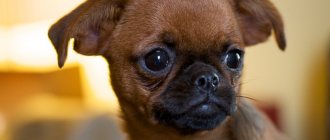The Brussels Griffon is a small, cheerful dog with a funny expression on its face. Despite her extravagant appearance due to her upturned nose and unkempt beard, she has aristocratic manners. This smart, cheerful and active dog can become a favorite of the whole family, a devoted companion. Previously, griffons were used as watchmen and rat catchers. Now the breed is classified as decorative. Before you get this dog, you need to learn everything about the Brussels Griffon breed. Reviews from owners and videos will help you get acquainted with the pros and cons of the content and learn about character traits.
- How do Belgian, Brussels and Brabant Griffons differ from each other?
- Head
- Education and training
- Grooming
Breed characteristics
| Short description | |
| Origin: | Belgium |
| Conditions of detention: | In an apartment, in a house without a garden |
| Purpose: | Companion |
| Color: | Reddish reddish, black |
| Wool length: | Short, up to 2 cm inclusive |
| Adult dog sizes: | The height of males is 18 – 20 cm, the height of females is 16 – 18 cm; males weigh 4.5 – 5.5 kg; females weight 2.5 – 4.5 kg |
| Average life expectancy: | 12 – 15 years |
| Walk: | Needed, 1 time per day |
| Physical activity needs: | Average physical activity needs (walking 1 to 3 hours per day) |
| Fédération Cynologique Internationale (FIC) classification: | Group 9. Toy dogs and companion dogs. Section 3. Small Belgian dogs |
| Puppy price: | 15,000 – 40,000 rubles |
Nutrition
List of foods NOT suitable for feeding Griffon puppies and adult Griffons:
- Food from the table: soup, porridge, cutlets, etc.
- Sausages of all types
- Pork in any form
- Uncooked chicken and other poultry
- River fish in any form
- Milk
- Potato chips, all kinds of commercially prepared crackers.
- Chocolate, sweets, ice cream, flour confectionery
- Potatoes, legumes
- Large bones
- Boiled bones of any size, incl. chicken
History of the origin of the species
The homeland of the Brussels Griffon is Belgium. This purebred dog originated from the local breed "Smoosier" (a type of mongrel that lived in the yards of local peasants). By crossing this dog, three similar breeds were obtained: Pit Brabançon (Braban), Belgian and Brussels Griffon .
It is known that the Belgian Queen Marie-Henrietta loved these dogs very much. She kept Belgian Griffons as lap dogs. Gradually, small, cute companion dogs became popular outside of Belgium, and they began to be exported to other European countries. They came to Russia at the beginning of the 20th century.
At first, griffons were bred to protect wooden carts, carriages, and carriages from rats. For this purpose they were kept in the yard or kennel.
Then representatives of high society appreciated the loyalty and devotion of this breed, and began to use griffons as companions. Then they received “registration” in the houses. Ladies of the court and members of the royal family often took their pets on long trips and to social events.
Interesting Facts
Brussels Griffons are charismatic dogs with a rich history, which has accumulated a lot of interesting things:
- The name of the breed has nothing to do with the mythological creature with the body of a lion and the head of an eagle, but reflects the characteristics of the dog’s hair. Translated from French, the word "griffon" means "wiry-haired".
- These dogs were once used to kill rodents and lived in barns, stables and haylofts. That's why they used to be called stable griffons.
- The Brussels Griffons lived at the court of Draga Srpska. The queen was afraid of being poisoned and checked whether the food was dangerous by giving it to the dogs to try. One of her pets died after eating another portion of the treat, which saved the owner’s life.
Distinctive features
Despite its small size and short stature, the griffon is distinguished by physical strength and endurance.
Here's how you can describe the appearance of this dog:
- The ears are small, high-set, and located far from each other. If the ears are not cropped, they are half erect and hang forward. When the ears are cropped, they become pointed and stand up;
- The tail is set high. When the tail is docked, it is shortened to exactly two-thirds of its original length. If the tail is not docked, it stands vertically, the tip is oriented towards the back, does not curl, just slightly bent. The tail is short and has a characteristic crease. If the tail curls into a spiral, this indicates that the dog is not purebred;
- The eyes are set wide apart and have a pronounced round shape. They are never convex. Eye color is usually brown. The dark brown color indicates the purity of the breed. The pupil has a black rim, the whites are practically invisible;
- Body - the neck is of medium length, almost merging with the body. The length of the body is the same as the height. The body has the shape of a regular square;
- Color – red or slightly reddish, light brown. There may be small dark, almost black spots on the head. There is a combination of black and red-brown color. In older animals, the mask may be pearly gray. There may be a small amount of white hair on the chest, but this is not encouraged at shows;
- The coat is hard, thick and short undercoat. Slightly frizzy. The fur above the eyes lengthens sharply, smoothly turning into the eyebrows.
- Nose – large, open nostrils with a wide bridge of the nose. The eyes and bridge of the nose are located on the same line. The nose tilts back slightly. In profile, it is on the same vertical line with the forehead and chin.
Breed description, standards, appearance
The Brussels Griffon is a strong, well-balanced dog with a compact, almost square body and strong bones. According to the international classification, the breed belongs to the group of companion dogs and toy dogs and to the section of small Belgian dogs without testing for working qualities.
Size and constitution
Brussels Griffons are miniature dogs whose weight varies between 3.5-6 kg. According to FCI standard No. 80 they must comply with the following description:
- The head is large with a wide, rounded skull, a steep stop, a wide, slightly protruding chin and a very short muzzle. The nose is small with well-opened nostrils and a black nose. The wide lower jaw curves upward and protrudes beyond the upper. The lips are black, tightly fitting, without jowls. Cutters included. Bite – snack.
- The eyes are round, large, widely set with a meaningful expression, brown iris and tightly drawn eyelids.
- The ears are set high, small, semi-erect. Sometimes they stop.
- The body is almost square in format with a moderately long neck that smoothly blends into the shoulders, slightly raised withers, a short, level back, a muscular, slightly convex loin and a wide, straight or slightly sloping croup. The chest is deep, developed with well sprung ribs. The abdomen is moderately tucked.
- The limbs are widely set, straight, parallel with well-developed bones, small, rounded paws, tightly clenched toes, thick pads and strong black claws. Movement is powerful with good drive from the hind legs.
- The tail is set high and carried up, without curling or touching the back. Often docked at 2/3 of the natural length.
Any deviations from the norms prescribed in the breed standard are considered a fault. The severity of defects depends on their severity and impact on the dog's health and functionality.
Color and coat type
Brussels Griffons are wire-haired dogs with a coarse, slightly wavy coat and developed down. Longer hair grows on the head, forming characteristic eyebrows above the eyes and a mustache and beard on the muzzle. A silky or curly coat is considered a serious fault.
According to the breed standard, only 2 color options are allowed - red and fawn. Slight blackening of the decorating hair on the head is acceptable.
Photo of an adult dog
Hygiene
Hygiene is quite simple - little more difficult than when working with short-haired dogs.
- Every week you need to comb out the hair - a comb with sparse teeth is suitable for this.
- Griffon grooming should be done as rarely as possible - only before performances and exhibitions.
- But partial trimming of the griffon will have to be done every month - it is necessary to trim the hair near the anus so that it does not get dirty.
Important! After each meal, you need to wipe or wash the “beard” - it constantly gets dirty.
Examination of eyes and ears - every day. If your eyes are watery, wipe them with a cotton swab dipped in tea leaves. Clean your ears with ear sticks slightly moistened in warm water.
Tartar can cause certain problems - to prevent its occurrence, it is advisable to regularly give the dog bones or toys that are intended for dogs that like to chew something.
A gorgeous beard is the pride of a griffin
Photos of puppies
Characteristics and description of varieties
As mentioned above, the concept of griffon often includes several breeds bred in parallel. To better understand the issue, you should study each of them separately.
They do not differ too much in size - on average, height at the withers is 26-32 centimeters with a weight of about 3.5-6 kilograms. But still there are differences and very noticeable ones.
Brussels
Perhaps the most common member of the family. It has a very hard, wiry coat. Not too long, but very thick, allowing both to withstand bad weather and protect against rat bites.
The main color is brown and all its shades. Quite often there is a black mask on the face.
Belgian
Externally, the Belgian Griffon is similar to the Brussels Griffon. In fact, the only difference is the color - this breed is characterized by black and black and tan coats.
Brabançon
If the reader is interested in the smooth-haired griffon, then he should give preference to the Brabançon (not the Barbados, as some believe!). Or, more precisely, Petit Brabançon - that’s what this breed is called.
Her coat is short, but at the same time quite tough. There are different colors: red, black, black and tan. Moreover, red-haired individuals often have a black mask.
British (English) fawn basset griffon
The breed developed in parallel from those listed above and, in fact, apart from a similar name, has nothing in common.
Basset griffins are much larger - at the withers about 39-45 cm with a weight of 18-20 kg.
The ears are long and the coat is straight. The color can be tri-color, but in most cases white dogs are found.
Corthals Griffon or French Wirehaired Griffon
The Korthals Griffon is not at all similar to the Belgian.
Like the Basset Griffon, it has nothing to do with the small Belgian breeds. Actually, it’s not even a griffon, but a pointer. Height at the withers is 50-60 cm (bitches are usually about 5 cm shorter).
They were bred in the mid-sixteenth century and were actively used in hunting. The coat is tough, but feels more like boar bristles than wire, like real griffons.
The usual color is steel gray, sometimes with brown markings. But the standard also allows brown-white, brown-roan, and any combination of these colors.
Features of character and behavior
The Brussels Griffon is distinguished by its sociability and loyalty; it is very devoted to its owner. But, at the same time, this little dog is often jealous and has truly “donkey” stubbornness. Therefore, in order to train a griffin, you need to have a strong character. Each puppy needs an individual approach.
Advantages
The Brussels Griffon is a very sociable and loyal dog.
Among the merits of character and behavior, the following can be noted:
- Accepts children and small pets well. Maybe, for example, make friends with a cat (if the animals know each other from an early age);
- Loves outdoor games;
- Shows virtually no open aggression;
- It is distinguished by its vigilance and will not allow a stranger to see its owner.
This breed is perfect for a family with a child or children over five years old. But it is not recommended to leave an animal with children unattended, since in a fit of joy the dog can accidentally harm the child.
Flaws
Despite the obvious advantages, this breed also has disadvantages, for example:
- The dog becomes too attached to the owner and may react poorly to other family members and may be jealous of children;
- The animal is stubborn and therefore difficult to train. For training you will need the help of a professional;
- The playful fidget dog loves to misbehave. May surreptitiously bite children;
- The Griffon loves to bark and has a ringing, loud voice, so it can disturb the peace of neighbors and household members.
These shortcomings can be easily corrected if you contact a professional dog trainer to raise and train the dog.
Training and education
Brussels Griffon puppies are very intelligent and easy to train. Mastering new skills occurs quickly, but this is more typical for a young age. As the pet grows up, it studies the owner’s character and learns the boundaries of what is permitted. Because of this, he may sometimes shirk or be stubborn. In such cases, it is important to be persistent and consistent in order to convince the dog to follow the command.
You should not raise your voice, as the griffon is good at detecting changes in the owner’s mood. Rudeness can lead to disobedience, but a calm attitude can return the dog to the learning process. Mastering basic skills takes place in just a week. At first, you should reward your pet with treats for each completed command. Later it should execute them automatically.
Care and maintenance
- The Brussels Griffon needs to regularly clean its ears and check for ear mites. To prevent ear mites, animals are treated with antiparasitic agents.
- The weak point of these animals is their teeth . Plaque often accumulates on them, causing the development of tartar. To prevent this disease, animals should be periodically given hard bones and raw vegetables (carrots, potatoes) to chew on, but sweets should not be given.
- Griffons also often have problems with their eyes. The hair hanging over the eyebrows must be carefully trimmed so that constant hair getting into the eyes does not provoke conjunctivitis. If purulent discharge from the eyes appears, the animal can be given an antihistamine (as recommended by a veterinarian) and the eyes can be wiped with strong tea leaves for several days.
- You don't need to trim your nails often because they don't grow that fast . Sometimes the griffon begins to behave like a cat: scratching furniture with its claws. This way the animal grinds down its claws. In this case, you need to purchase a special scratching post for the dog. It is best to give your pet a “manicure” at a veterinary clinic or in a salon, because the griffon does not like this procedure, and it is quite difficult to hold it in place while trimming its claws.
- This breed of dog is distinguished by its agility and activity. They will happily play with a child's rubber ball, toy bone, or rubber squeaky toys. You should not give toys with small rattling parts inside, as a curious puppy will definitely chew or bite them.
- The Griffon is very attached to his home and his place, so the puppy must immediately be taught to sleep only on his own rug. You cannot take your dog into your bed, otherwise the animal will quickly get used to it.
The Griffon is not a chain dog; it will not withstand prolonged isolation from its owners, even in the most comfortable booth. These animals need activity and communication, so you can only keep a dog at home. In addition, they are very sensitive to temperature changes.
Nutrition
The animal should never be overfed: the griffon, like other small dogs, has a genetic predisposition to obesity and diabetes.
Meals should be frequent: several times a day, in small portions.
Your animal's daily diet should include:
- Fresh vegetables. Griffins enjoy gnawing on carrots and apples; these products enrich the body with vitamins and prevent the formation of tartar;
- Cartilaginous bones. They have a beneficial effect on teeth and help strengthen bones;
- Raw meat (beef, lamb);
- Boiled chicken or pork;
- Oatmeal and rice porridge with water or milk.
It is strictly forbidden to give the animal smoked meats and industrially produced sweets. From early childhood, your dog should be weaned from begging for pieces from the table. The owner must learn to firmly say “no” to the animal.
An adult dog needs to be fed 3 times a day, a puppy – 5 times. The easiest way to calculate the portion is by experiment: if the dog does not eat everything in the bowl at one time, the portion should be reduced. And, conversely, if the animal asks for more and looks hungry, the portion can be increased.
- It is best to feed puppies commercially produced food and give additional calcium supplements.
- Milk and infant formula are not suitable for them due to lactose intolerance.
- Starting from three months, fermented milk products are gradually introduced into the diet.
- If you want to feed your baby natural products, you can give your puppy mashed potatoes, rice and oatmeal, well-cooked porridge.
- Gradually, meat and fish are introduced into the diet, as well as (in limited quantities) offal, which must be boiled.
The animal must have a bowl of water. The water needs to be changed every day. If there are several dogs in the house, each should have a separate water bowl. Stale water can lead to diarrhea. You cannot give your dogs tap water; only boiled or bottled water will do.
As they grow older, the dishes need to be changed, since it is inconvenient for a large dog to eat and drink from a small bowl, and this can lead to problems with posture and bite.
Health
- Before adopting a puppy, you need to carefully study its pedigree , since these animals often have serious hereditary diseases (for example, malignant tumors and hydrops of the brain, gynecological diseases and anomalies in bitches).
- Griffons are sensitive to drafts and bright sun, and they often suffer from colds and heat strokes . Allergy to raw fish, individual intolerance to raw chicken and pork are often noted.
Vaccinations
The first vaccination is given at two months, it is repeated after three weeks, and then the animal is vaccinated annually.
You cannot vaccinate if your dog is suffering from an acute infection. Bitches should not be vaccinated during estrus, as this weakens the immune system.
- To prepare your puppy for vaccination, you need to organize a gentle daily routine for him within two to three days before vaccination.
- During the cold season, it is better to refrain from walking; do not overfeed your pet.
- It is better to refrain from contact with other animals and quarantine the puppy for several days so that the dog does not become infected with viral infections before vaccination.
Animals tolerate vaccination well, but after the first vaccination the dog may be fearful and restless for several days. The temperature may rise slightly, and there may be allergic discharge from the eyes. As a rule, these phenomena go away on their own a few days after vaccination.
The Griffon, like other dog breeds, must be vaccinated against rabies (even if the dog is kept exclusively at home, without walking). It is also necessary to get vaccinated against such serious diseases as:
- Plague;
- Leptospirosis;
- Viral hepatitis;
- Laryngotracheitis (a dangerous viral disease that causes swelling and stenosis of the larynx).
Before vaccination, the animal must be examined by a veterinarian. If the dog feels unwell, vaccination is postponed until complete recovery.
Diseases
Due to the peculiarities of the anatomical structure of the eyes, the following diseases often occur in animals:
- myopia (nearsightedness);
- cataract;
- retinal dystrophy;
- viral and bacterial conjunctivitis;
- In small puppies, obstruction of the tear ducts is possible.
Bitches often have complications during childbirth, miscarriages, and stillbirth of puppies. Puppies have increased intracranial pressure caused by fluid accumulation in the brain (called “dropsy”).
Health and diseases of Brussels Griffons
Representatives of the breed are distinguished by strong immunity to viral and colds. However, dogs are characterized by common pathologies:
- hydrocephalus (water on the brain);
- distichiasis (presence of extra eyelashes);
- loss of eyeballs;
- complications during childbirth;
- cyst in the spinal cord;
- retinal atrophy;
- Perthes disease;
- narrow nostrils;
- cataract.
Daily walks, age-appropriate feeding regimen, timely vaccination, treatment for parasites - these are the keys to the longevity and health of your pet. If suspicious symptoms are detected, you must make an appointment with a veterinary clinic.
Walk
The Griffon, like other small dogs, does not need much physical activity.
- This is very convenient for older breeders or for those who, due to their busy schedule, cannot walk their pet every day.
- If you train a dog to use a litter box, it can do without walking, but in this case you should definitely play outdoor games with the animal in the apartment to prevent obesity.
- Griffons that are walked daily look better, grow and develop faster, and have a higher intellectual level.
- The duration of the walk should not exceed an hour to an hour and a half. Active physical activity (running, jumping) should be avoided, as the animal gets tired quickly.
You should also not walk in crowded areas or take your dog on public transport, as griffins are very shy. It is better to walk in a specially designated area. If your dog becomes stubborn during a walk, you need to carefully switch its attention to something new. The dog is easily distracted and obeys the owner's orders.
History of the Belgian Griffon breed
The Belgian Griffon is a breed whose history is “documented” in the paintings of the Renaissance.
Confirmation of this is the famous “Portrait of the Arnolfini Couple” by Van Eyck, in which a miniature dog with a Griffon-like appearance approaches the hem of the dress of a female figure. Images of shaggy pets are also found in the engravings of Albrecht Durer, which makes it possible to determine the approximate age of the breed, which is almost 600 years. By the way, it is still not possible to find out which dogs gave the Belgian griffons such a touching exterior. Most often, Affenpinschers and ruby Cavalier King Charles Spaniels are suspected in this case, to whose blood the genes of Pugs and Yorkies were later mixed. At first, the ancestors of griffons lived in stables and were engaged in not the most noble craft. More specifically, the animals were purposefully bred to catch rats that ate horse oats. After a while, the local nobility became interested in the tiny dogs - their amusing appearance and toy dimensions turned griffons into funny pets that were convenient to keep in their chambers or take to balls. Everyone who had at least a minimal understanding of selection immediately rushed to satisfy the needs of the elite; as a result, the Belgian kingdom was filled with small dogs with coarse hair and flattened faces.
“Belgians” began to appear at exhibitions in 1883, although at that time they were combined into one breed with Brussels Griffons. Around the same time, breeders in Foggy Albion became interested in animals, so soon Belgian griffons began to leave for England straight from the show rings. In 1904, the breed was finally standardized and completely separated from its relatives, the Petit Brabançons and the Brussels, which increased its popularity among Western and European dog breeders.
An important point: in order to obtain healthy offspring, Belgian Griffons are allowed to breed both with each other and with other representatives of the group of small Belgian dogs (Brussels Griffons, Petit Brabançons).
Grooming
The griffon's molting occurs almost unnoticed by its owners, and this is very convenient. This breed very rarely causes a reaction in people who are allergic to dog hair.
- To keep the coat looking beautiful, dead pieces of fur need regular plucking . When this procedure is carried out correctly, the dog does not suffer any pain, so the animal tolerates the procedure calmly, without showing negative emotions.
- After this, the wool becomes much softer and more pleasant to the touch. This is a long and painstaking work, so it is best to go to a professional grooming salon, where this manipulation will take no more than an hour and a half.
- The muzzle is trimmed to make the dog look beautiful and neat . When grooming, you should be especially careful in the eye area so as not to accidentally cause serious injury to the animal.
- It is advisable to use a special glove for grooming; when using it, the animal sheds much less. It is necessary to regularly clean the characteristic folds on the muzzle, otherwise inflammation or dermatitis may occur under the folds.
- The coat should be brushed regularly with a hard brush with short bristles, in the direction of its growth. You need to comb it at least twice a week.
- After each walk, the animal's paws are washed. Pets are bathed very rarely: the less frequently, the better. They do not tolerate washing well and get cold easily, so you should only rinse the animal in the shower if it is very dirty. When washing, shampoos and anti-parasitic agents for decorative dogs are used.
Health
Brussels Griffons are not particularly healthy; their life expectancy is 12-14 years. They have a predisposition to certain diseases. As a rule, pathologies of the organs of vision are especially common among them. Griffons are susceptible to the following diseases:
- cataract;
- narrowing of the nostrils;
- eyelash growth;
- retinal atrophy;
- prolapse of the eyeball;
- hydrocephalus.
Another feature of the breed is difficult childbirth, often ending in caesarean section.
Mating
There are several varieties of Brussels Griffons, each with its own characteristics of color, anatomical structure of the body and muzzle . It is better to knit animals that look approximately the same. Before mating, you should study the pedigree of your partner. In no case should you carry out mating if the partner turns out to be not purebred or has serious breed defects.
Even if the dog meets all the standards, it is quite possible that the puppies will inherit the deficiencies that exist in the family. Suitable age for mating is one year (for a male), one year and three months (for a female). If the dog does not feel well, breeding should be postponed until complete recovery. Breeding dogs that suffer from acute or chronic infectious diseases can lead to the birth of puppies with serious defects.
Before mating, both animals need to be treated for worms and fleas (ticks, lice eaters), and vaccinated against rabies.
Animals should not be overfed on the eve of an important event . It should be kept in mind that an overweight bitch is less likely to conceive a puppy. There is no need to rush into mating. If you breed a female dog during her first heat, her immune system may be weakened and serious health problems may develop. It is better to let your pet get stronger and gain strength.
Breeding
It is very difficult to breed them. Most often, a cesarean section is necessary for a successful birth. The litters are small. Puppies, unfortunately, very often die in infancy.
Key points of training
- During training, you should not try to “break” the animal’s stubbornness.
- In order for a griffon to do something, he must want it himself.
- Any violence will only embitter the dog and will not bring results. You need to work with the animal every day, but not for long, as this breed gets tired quickly. It is necessary to develop in animals such qualities that are inherent in them by nature, such as dexterity, attentiveness, activity and curiosity.
- Read about how to properly train a dog in the article: “Training a puppy: effective methods from dog handlers, learning commands at home.”
Personality of the Belgian Griffon
Belgian Griffons are comfortable pets in every sense. Playful, but not annoying, emotional, but easily controlled, these funny little eyes are observant and subtly sense when the owner needs to cheer up, and when it is better not to be zealous and go about their business. At the same time, human-orientedness is considered the main advantage of the breed, which is especially valuable in cases where the animal’s company is intended to brighten up everyday life, for example, for people with limited mobility and elderly owners.
Griffons do not compete with representatives of domestic fauna. Moreover, they absolutely do not care with whom they share their living space: with rodents, a family of cats or arrogant shepherds. These tiny pacifists are ready to do anything to maintain a peaceful atmosphere and quickly find their niche in the hierarchical system of the animal world. However, one should not confuse conflictlessness with outright cowardice. “Belgians” are very responsive to provocations and injustice from their own kind, therefore, if your charge is threatened by some Great Dane on the street, the tiny “bearded man” will not be too lazy to respond to the rudeness with a loud bark.
Belgian Griffons have a hard time putting up with loneliness, so it is advisable for the animal to live in a family where someone from the household will always be nearby. In addition, the breed has an amazing memory for faces and actions - the pet not only recognizes friends who appear in your house, but also builds an individual line of behavior for each. In the company of people from his inner circle, the Belgian Griffon behaves in a relaxed, trusting and friendly manner, coming up with various tricks and harmless pranks to attract attention to his own person. But strangers have to undergo a check when they first encounter a representative of this breed. At the sight of a stranger, the griffon turns on a mild suspicion mode, which gradually fades away if the two-legged “alien” does not try to offend the animal or the owner.
Belgian Griffons do not suffer from melancholy or depression; they are on a wave of positivity and willingly engage in play activities. At the same time, entertainment always requires a companion, which can be either the owner or any four-legged creature that is ready to perceive the griffon as an equal.
How to choose a puppy
It is best to purchase a puppy from a nursery. When choosing, you should pay attention to the behavior of the kids. If the puppy behaves actively, cheerfully, energetically, and is not afraid of a stranger, this is an ideal choice.
You should not take animals whose eyes are festering or watery, as this may indicate the presence of an intrauterine infection, which is difficult to treat. You should not choose the largest puppies, as a large head may indicate increased intracranial pressure.
The Brussels Griffon is an excellent choice for people who love an active lifestyle and dream of a faithful, devoted, cheerful four-legged friend.
5 / 5 ( 1 voice )
Pros and cons of the breed
Brussels Griffons are charming dogs with clear leadership abilities. To ensure that life with them brings only pleasant surprises, you need to analyze the advantages and disadvantages of the breed in advance.
| pros | Minuses |
| Extravagant exterior | Intolerance of loneliness |
| Miniature sizes | Difficult relationships with children |
| Goodwill | Tendency to dominate |
Brussels Griffons are miniature dogs with an unusual appearance and a cheerful, cheerful disposition. They will be ideal companions for moderately active people who spend a lot of time at home and are not burdened with small children.
